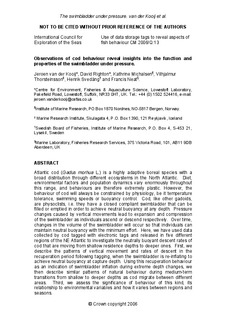| dc.description.abstract | Atlantic cod (Gadus morhua L.) is a highly adaptive boreal species with a
broad distribution through different ecosystems in the North Atlantic. Diet,
environmental factors and population dynamics vary enormously throughout
this range, and behaviours are therefore extremely plastic. However, the
behaviour of cod will always be constrained by physiology, be it temperature
tolerance, swimming speeds or buoyancy control. Cod, like other gadoids,
are physoclists, i.e. they have a closed compliant swimbladder that can be
filled or emptied in order to achieve neutral buoyancy at any depth. Pressure
changes caused by vertical movements lead to expansion and compression
of the swimbladder as individuals ascend or descend respectively. Over time,
changes in the volume of the swimbladder will occur so that individuals can
maintain neutral buoyancy with the minimum effort. Here, we have used data
collected by cod tagged with electronic tags and released in five different
regions of the NE Atlantic to investigate the neutrally buoyant descent rates of
cod that are moving from shallow residence depths to deeper ones. First, we
describe the patterns of vertical movement and rates of descent in the
recuperation period following tagging, when the swimbladder is re-inflating to
achieve neutral buoyancy at capture depth. Using this recuperation behaviour
as an indication of swimbladder inflation during extreme depth changes, we
then describe similar patterns of natural behaviour during medium-term
transitions from shallow to deeper depths as cod migrate between different
areas. Third, we assess the significance of behaviour of this kind, its
relationship to environmental variables and how it varies between regions and
seasons. | en |
